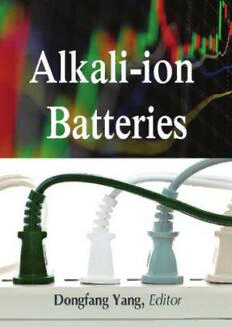
Alkali-ion Batteries PDF
Preview Alkali-ion Batteries
Alkali-ion Batteries Edited by Dongfang Yang Alkali-ion Batteries Edited by Dongfang Yang Stole src from http://avxhome.se/blogs/exLib/ Published by ExLi4EvA Copyright © 2016 All chapters are Open Access distributed under the Creative Commons Attribution 3.0 license, which allows users to download, copy and build upon published articles even for commercial purposes, as long as the author and publisher are properly credited, which ensures maximum dissemination and a wider impact of our publications. After this work has been published, authors have the right to republish it, in whole or part, in any publication of which they are the author, and to make other personal use of the work. Any republication, referencing or personal use of the work must explicitly identify the original source. As for readers, this license allows users to download, copy and build upon published chapters even for commercial purposes, as long as the author and publisher are properly credited, which ensures maximum dissemination and a wider impact of our publications. Notice Statements and opinions expressed in the chapters are these of the individual contributors and not necessarily those of the editors or publisher. No responsibility is accepted for the accuracy of information contained in the published chapters. The publisher assumes no responsibility for any damage or injury to persons or property arising out of the use of any materials, instructions, methods or ideas contained in the book. Publishing Process Manager Technical Editor AvE4EvA MuViMix Records Cover Designer Спизжено у ExLib: avxhome.se/blogs/exLib First published June 02, 2016 Stole src from http://avxhome.se/blogs/exLib: ISBN-10С: п95и3з-5ж1-е2н39о6 -у3 ExLib: avxhome.se/blogs/exLib ISBN-13: 978-953-51-2396-5 Print ISBN-10: 953-51-2395-5 ISBN-13: 978-953-51-2395-8 C ontents Preface Chapter 1 Carbon Nanofiber-Based Materials as Anode Materials for Lithium-Ion Batteries by Yunhua Yu, Yuan Liu and Xiaoping Yang Chapter 2 Capacity Optimization Nanotechnologies for Enhanced Energy Storage Systems by Natasha Ross and Emmanuel I. Iwuoha Chapter 3 Cathode Materials for Lithium Sulfur Batteries: Design, Synthesis, and Electrochemical Performance by Lianfeng Duan, Feifei Zhang and Limin Wang Chapter 4 Metal Hydride-Based Materials as Negative Electrode for All- Solid-State Lithium-Ion Batteries by Liang Zeng, Koji Kawahito and Takayuki Ichikawa Chapter 5 Intercalation of Poly[Oligo(Ethylene Glycol) Oxalate] into Vanadium Pentoxide Xerogel: Preparation, Characterization and Conductivity Properties by Evans A. Monyoncho, Rabin Bissessur, Douglas C. Dahn and Victoria Trenton Chapter 6 Highly Functionalized Lithium-Ion Battery by Hiroki Nagai and Mitsunobu Sato Chapter 7 Stress Analysis of Electrode Particles in Lithium-Ion Batteries by Yingjie Liu and Huiling Duan VI Contents Chapter 8 High-Voltage Cathodes for Na-Ion Batteries: Sodium– Vanadium Fluorophosphates by Paula Serras, Verónica Palomares and Teófilo Rojo Chapter 9 Vanadium Pentoxide (V2O5) Electrode for Aqueous Energy Storage: Understand Ionic Transport using Electrochemical, XRay, and Computational Tools by Daniel S. Charles and Xiaowei Teng Preface This book covers selected topics in different aspects of science and technology of alkali-ion batteries written by experts from international scientific community. Through the 9 chapters, the reader will have access to the most recent research and development findings on alkali-ion batteries through original research studies and literature reviews. This book covers inter-disciplinary aspects of alkali-ion batteries including new progress on material chemistry, micro/nano structural designs, computational and theoretical models and understanding of structural changes during electrochemical processes of alkali-ion batteries. Chapter 1 Carbon Nanofiber-Based Materials as Anode Materials for Lithium-Ion Batteries Yunhua Yu, Yuan Liu and Xiaoping Yang Additional information is available at the end of the chapter http://dx.doi.org/10.5772/63235 Abstract Considerable efforts have been devoted to the research of high-performance and long- lifespan lithium-ion batteries (LIBs) for their applications in large-scale power units. As one of the most important components in LIBs, anode plays an important role in determining the overall performance of LIBs. Nowadays, graphite has been the most successfully commercialized anode material. However, its limited theoretical capacity (372 mA h g−1) and limited power density seems insufficient for the next-generation LIBs. To overcome these problems, new materials with fundamentally higher capacity and higher power density are urgently needed. Recently, there is an ever-increasing interest in developing novel carbonaceous nanomaterials to replace graphite as the anode materials for LIBs. Such materials have included carbon spheres, carbon nanotubes, carbon nanofibers (CNFs), porous monoliths, and graphene. Among these alternative forms of carbon, CNFs and its morphological-controlled derivatives (such as porous or hollow CNFs) have attracted much attention due to their unique and interesting properties such as one-dimensional (1D) nanostructure, good electronic conductivity, and large surface areas. Moreover, these CNFs can be used to encapsu‐ late various second phases to form some functional composite, meeting further requirements including higher energy density, higher power density or flexible requirements, for the advanced LIB operation. Electrospinning is considered as a simple, versatile, and cost-effective industry-viable technology for preparing various CNFs and their composites in a continuous process, with controllable morphology. Therefore, in this chapter, we have summarized some recent progresses in electrospun nanofibrous carbon-based anode for LIBs, covering the structure evolution from solid CNFs into morphology-designed CNFs, and then their composites with various functional nanoparticles. We anticipate this paper can offer some useful information for some researchers in the area of energy storage and conversion and can inspire them. Keywords: electrospinning, carbon-based nanofibers, anode, lithium-ion batteries, nanomaterials
